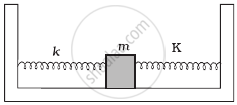Advertisements
Advertisements
Question
let us take the position of mass when the spring is unstretched as x = 0, and the direction from left to right as the positive direction of the x-axis. Give x as a function of time t for the oscillating mass if at the moment we start the stopwatch (t = 0), the mass is
(a) at the mean position,
(b) at the maximum stretched position, and
(c) at the maximum compressed position.
In what way do these functions for SHM differ from each other, in frequency, in amplitude or the initial phase?
Solution 1
(a) x = 2sin 20t
(b) x = 2cos 20t
(c) x = –2cos 20t
The functions have the same frequency and amplitude, but different initial phases.
Distance travelled by the mass sideways, A = 2.0 cm
Force constant of the spring, k = 1200 N m–1
Mass, m = 3 kg
Angular frequency of oscillation:
`omega = sqrt(k/m)`
`= sqrt(1200/3)= sqrt400 = 20 rad s^(-1)`
a) When the mass is at the mean position, initial phase is 0.
Displacement, x = Asin ωt
= 2sin 20t
b) At the maximum stretched position, the mass is toward the extreme right. Hence, the initial phase is `pi/2`
Displacement , `x = Asin(omegat + pi/2)`
`= 2sin (20t + pi/2)`
= 2cos 20t
(c) At the maximum compressed position, the mass is toward the extreme left. Hence, the initial phase is `(3pi)/2`
Displacement, `x = Asin(omegat + 3pi/2)`
`= 2sin (20t + 3pi/2) = - 2 cos 20 t`
The functions have the same frequency (`20/(2pi) Hz`) and amplitude (2 cm), but different initial phases `(0, pi/2, (3pi)/2)`
Solution 2
a =2 cm, omega = `sqrt(k/m) = sqrt(1200/3) s^(-1)= 20s^(-1)`
a) Since time s measured from mean position
b) At the maximum stretched position, tyhe body is at the extreme right position. The initial phase is `pi/2`
`:. x = a sin (omegat + pi/2) = a cos omegat = 2 cos 20 t`
c) At the maximum compressed position, the body is at the extreme left position. The initial phase is `(3pi)/2`
`:. x = a sin (omegat + (3pi)/2) = - a cosomegat = - 2 cos 20t`
APPEARS IN
RELATED QUESTIONS
When the length of a simple pendulum is decreased by 20 cm, the period changes by 10%. Find the original length of the pendulum.
Answer the following questions:
A man with a wristwatch on his hand falls from the top of a tower. Does the watch give correct time during the free fall?
The cylindrical piece of the cork of density of base area A and height h floats in a liquid of density `rho_1`. The cork is depressed slightly and then released. Show that the cork oscillates up and down simple harmonically with a period
`T = 2pi sqrt((hrho)/(rho_1g)`
where ρ is the density of cork. (Ignore damping due to viscosity of the liquid).
A mass attached to a spring is free to oscillate, with angular velocity ω, in a horizontal plane without friction or damping. It is pulled to a distance x0 and pushed towards the centre with a velocity v0 at time t = 0. Determine the amplitude of the resulting oscillations in terms of the parameters ω, x0 and v0. [Hint: Start with the equation x = acos (ωt+θ) and note that the initial velocity is negative.]
Show that motion of bob of the pendulum with small amplitude is linear S.H.M. Hence obtain an expression for its period. What are the factors on which its period depends?
A simple pendulum has a time period of T1 when on the earth's surface and T2 when taken to a height R above the earth's surface, where R is the radius of the earth. The value of `"T"_2 // "T"_1` is ______.
If the maximum velocity and acceleration of a particle executing SHM are equal in magnitude, the time period will be ______.
A particle executing S.H.M. has a maximum speed of 30 cm/s and a maximum acceleration of 60 cm/s2. The period of oscillation is ______.
Which of the following statements is/are true for a simple harmonic oscillator?
- Force acting is directly proportional to displacement from the mean position and opposite to it.
- Motion is periodic.
- Acceleration of the oscillator is constant.
- The velocity is periodic.
Two identical springs of spring constant K are attached to a block of mass m and to fixed supports as shown in figure. When the mass is displaced from equilibrium position by a distance x towards right, find the restoring force

